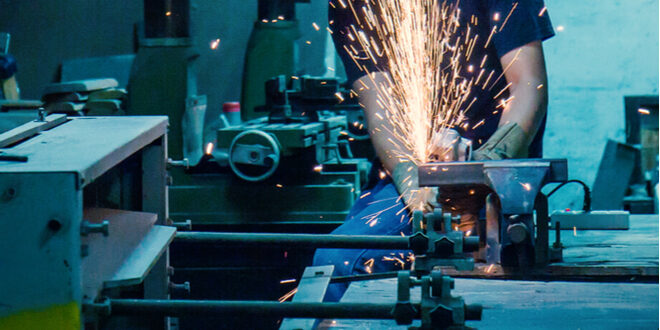The region’s purchasing managing index dipped below 50 for the third consecutive month in December, which means that the sector is contracting, not expanding. One person who helps compile that monthly data says she expects a quick recovery, but some obstacles must be overcome to make that happen.
Barbara Sirotnik is not hitting the panic button.
Not yet, anyway.
Sirotnik is the director of the Institute of Applied Research and Policy Analysis at Cal State San Bernardino. Every month, the institute publishes its Report On Business, which breaks down the state of manufacturing in the Inland Empire.
The centerpiece of the report is the purchasing manager index, which is based on a survey of 100 purchasing managers in Riverside and San Bernardino counties.
An index of 50 or higher means manufacturing in both counties is expanding. Forty-nine or below means it’s getting smaller and, by implication, that the Inland economy is moving in the wrong direction.
Three consecutive months in the same direction establishes a trend, so when the December index was released earlier this month – 47, following 49.6 indexes in October and November – the Inland manufacturing sector was officially contracting.
That trifecta never happened during the worst of the fallout from the pandemic, in 2020 and 2021. There were several instances of two consecutive months below 50, but the index always bounced back in the third month.,
In fact, the index was 50 or better from September 20 through July of last year, a streak of 23 consecutive months.
Determining what causes a manufacturing slowdown is not always easy. However, in this case, inflation, persistent rumors of a recession, and supply issues at the ports of Los Angeles and Long Beach were certainly factors, according to Sirotnik.
“There could be a recession this year, and that’s something we all need to be concerned about,” said Sirotnik, who co-authors the report. “But I’m an eternal optimist. Maybe the economy will slow down this year, maybe it won’t, but if we do have a recession it will come back sooner or later.”
The January index, scheduled to be released Feb. 1, will be below 50, but after that, it will creep back up and remain in the low to mid-50s until the end of the year, Sirotnik predicts. She does not believe the index will reach 60, which it has done occasionally in an overheated economy.
“Of course, a severe recession would be a disaster, but I’m not worried about that,” Sirotnik said. “I don’t believe that’s going to happen.”
The recent slowdown in manufacturing was not confined to the Inland Empire. The U.S. purchasing managers index was 48.4 in December, the second consecutive month the index has been below 50, according to the Institute for Supply Management, a not-for-profit trade association in Tempe, Az.
“The economy dropped off in 2020 and 2021, and it hasn’t come back all the way,” Sirotnik said. “In a lot of ways, the pandemic is still with us. But manufacturing also fell off in the United States, which helps explain why it fell off here.”
Inflation, particularly the high price of gasoline, is the single biggest factor in the decline in manufacturing, in the Inland Empire and the United States, according to Sirotnik.
“Inflation, and fear of inflation, have certainly been a big part of it,” Sirotnik said. “People are concerned about the economy, they don’t have as much money as they did a few years ago so they’re cutting back on their spending. Also, the labor shortage is still an issue.
“Too many people who could be working aren’t working. I’m not as optimistic about fixing that problem as I am about fixing some other things.”
Not all of the numbers in the December index were bad.
Production fell from 55.6 to 46.3 in December, but that was expected because production always falls during the holidays. New orders registered 46.3, better than the 37 recorded in November but still below 50.
Employment stayed the same between November and December, at 48.1, while the commodity price index fell from 61.1 to 51.9 month-over-month, the lowest number in that category in two and a half years.
Overall inventory – goods, not dollars – registered at 40.7, a huge decrease from November’s 51.9. That decline may be attributable to a depletion in raw materials needed to produce holiday goods, the index stated.
Only four percent of the purchasing managers surveyed said they expect the local economy to get better during the next three months, an unusually low number, while 46 percent said they expect it to get weaker.
But some purchasing managers expressed restrained optimism. Their comments include predictions of new orders “bouncing back” in January, being “brisk” for the end of the year, and that “things seem to be staying steady” as 2023 gets underway.
“Most of the purchasing managers we survey are pessimistic, but when you read the comments a lot of them said that if they can just get past this slight downturn they think they’ll be OK,” Sirotnik said.
One businessman who participates in the survey every month said he doesn’t believe a slight manufacturing drop is worth being too concerned about.
“I don’t worry about recessions, and I don’t worry about manufacturing coming back whenever it’s not doing well,” said Bud Weisbart, co-owner of A&R Tarpaulins in Fontana, which specializes in protective materials for the aerospace industry. “We make a product people need. There will always be a market for what we do.”
 IE Business Daily Business news for the Inland Empire.
IE Business Daily Business news for the Inland Empire.


